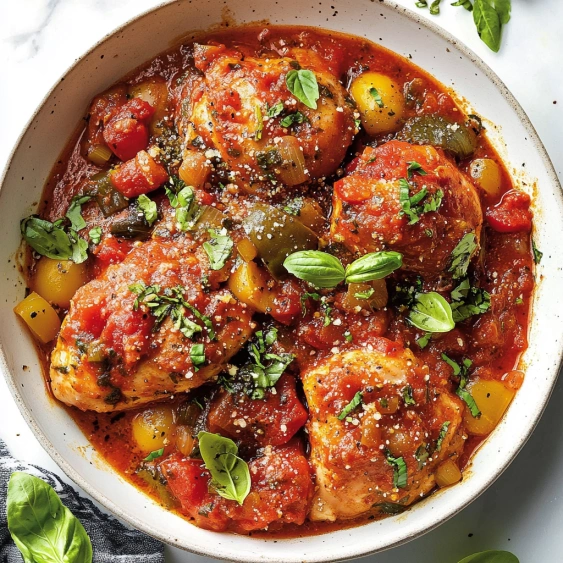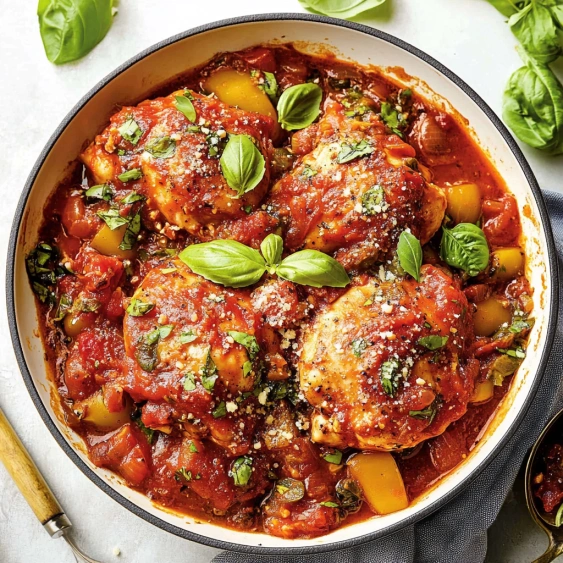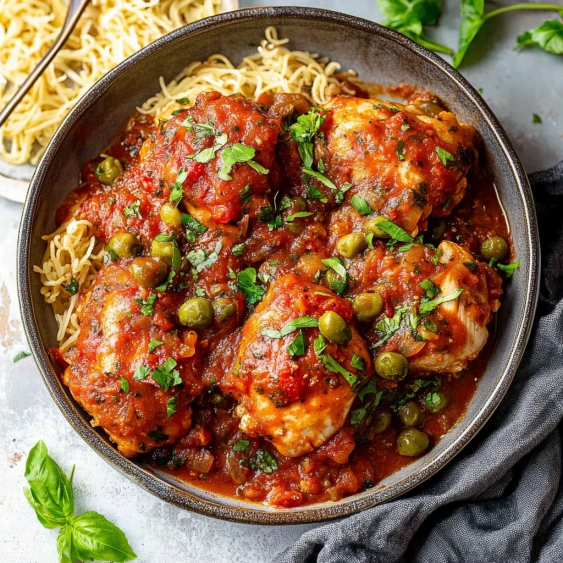 Pin it
Pin it
This rustic Chicken Cacciatore transforms humble ingredients into a rich, comforting Italian masterpiece that will transport you straight to the Italian countryside. The tender, fall-off-the-bone chicken swimming in a robust tomato sauce creates a meal that satisfies both body and soul.
I first made this cacciatore during a particularly harsh winter when we were snowed in for days. The aroma filled our home with such warmth that my family now requests it whenever the temperature drops below freezing.
Ingredients
- Bone in chicken thighs: These dark meat cuts become incredibly tender when slow cooked and provide more flavor than breast meat
- Flour: Creates a light coating that helps thicken the sauce and gives the chicken a beautiful golden exterior
- Butter and olive oil: The combination provides the perfect fat for searing with the butter adding richness and the oil preventing burning
- Yellow onion: Forms the aromatic base of the sauce with its natural sweetness that deepens as it cooks
- Carrots: Add subtle sweetness and beautiful color contrast to the dish
- Bell peppers: Traditional in cacciatore providing sweetness and texture to balance the acidity of tomatoes
- Mushrooms: Contribute earthy umami flavor and meaty texture making the dish more substantial
- Garlic: Essential flavor foundation that blooms in the oil creating aromatic depth
- Crushed and diced tomatoes: Provide the tangy base for the sauce while maintaining textural interest
- Heavy cream: Mellows the acidity of the tomatoes and creates a luxurious silky finish
- Capers or Kalamata olives: Add briny pops of flavor that cut through the richness
- Dried herbs: The combination of basil, oregano, rosemary, thyme and parsley creates an authentic Italian flavor profile
- Sugar: Balances the acidity of the tomatoes; only a touch is needed
Step-by-Step Instructions
- Season and dredge the chicken:
- Pat the chicken thighs completely dry with paper towels then coat them in the seasoned flour mixture pressing gently to ensure even coverage. The flour will help create a golden exterior and later thicken the sauce as it cooks. Shake off excess flour to prevent burning during searing.
- Sear the chicken:
- Heat the butter and oil in a large oven-safe skillet until shimmering but not smoking. Place the chicken in carefully without overcrowding and sear until deeply golden, about 4 minutes per side. This critical step develops the foundation of flavor through the Maillard reaction. Remove the chicken but treasure those browned bits in the pan.
- Build the aromatic base:
- Reduce the heat to prevent burning, then add more butter to the flavorful drippings. Add the diced onions, carrots, bell peppers and mushrooms, sautéing until they soften and release their moisture, about 10 minutes. The vegetables should become slightly caramelized but not browned. Add the garlic just for the final 30 seconds to prevent burning.
- Create the sauce:
- Pour in both types of tomatoes along with all remaining ingredients stirring to incorporate everything evenly. The tomato paste adds concentrated flavor while the cream balances acidity. Take time to scrape up any browned bits from the bottom of the pan as this is where tremendous flavor resides.
- Braise to perfection:
- Return the chicken to the pan, nestling the pieces into the sauce. Cover tightly and transfer to the oven where the magic happens over the next hour. The low consistent heat will gently cook the chicken until it becomes fall-apart tender while the flavors meld and intensify.
- Serve with flair:
- Decide whether to serve the chicken pieces whole or shredded into the sauce. Garnish generously with fresh basil and freshly grated Parmesan, which adds brightness and sharpness to contrast with the rich sauce.
 Pin it
Pin it
You Must Know
My grandmother taught me to always remove the chicken skin for this recipe. While controversial among some Italian cooks, she insisted it prevented the sauce from becoming too greasy and allowed the meat to better absorb the flavors. This small detail transforms the dish from good to unforgettable.
Make Ahead Options
Chicken Cacciatore actually improves with time making it perfect for entertaining. Prepare the entire dish up to two days ahead and refrigerate in an airtight container. Reheat gently on the stovetop or in a 325°F oven until warmed through stirring occasionally to prevent sticking. The flavors will have melded even more beautifully creating an even more complex taste.
 Pin it
Pin it
Serving Suggestions
While traditionally served over pasta, this versatile dish pairs beautifully with various bases. Try it over creamy polenta for an authentic northern Italian experience, or spoon it atop roasted garlic mashed potatoes to soak up every drop of the sumptuous sauce. For a lighter option, serve with roasted spaghetti squash or zucchini noodles. Always accompany with crusty Italian bread for sauce mopping, a non-negotiable tradition in Italian homes.
Historic Roots
Cacciatore translates to hunter style referring to this dish's rustic origins among hunters in central Italy. They would cook whatever game they caught with wild herbs, vegetables and wine available in the countryside. Our modern version uses chicken but maintains the essence of this peasant dish where simple ingredients transform through slow cooking into something extraordinary. Different Italian regions claim their own variations, some using white wine, others red, some with olives, others with capers, but all sharing the soul of comfort food.
Frequently Asked Questions
- → Can I use chicken breasts instead of thighs for Chicken Cacciatore?
Yes, you can substitute chicken breasts, but they tend to dry out more easily than thighs. If using breasts, reduce the cooking time to about 30-35 minutes and check frequently for doneness. For the best texture, boneless breasts work better than bone-in since they cook more quickly and evenly in this dish.
- → What's the best way to serve Chicken Cacciatore?
Traditionally, Chicken Cacciatore is served over pasta (pappardelle or fettuccine work beautifully), creamy polenta, or rice to soak up the flavorful sauce. For a lower-carb option, try serving it over zucchini noodles, cauliflower rice, or with a side of roasted vegetables and crusty bread for dipping.
- → Can I make Chicken Cacciatore ahead of time?
Absolutely! Chicken Cacciatore actually tastes better the next day as the flavors have time to develop. Make it a day ahead, cool completely, then refrigerate. Reheat gently on the stovetop or in a 325°F oven until hot throughout. The sauce may thicken in the refrigerator, so add a splash of chicken broth if needed when reheating.
- → What can I substitute for heavy cream if I want to make this dairy-free?
For a dairy-free version, you can substitute the heavy cream with full-fat coconut milk or cashew cream. Alternatively, you can simply omit the cream entirely - the dish will be slightly less rich but still delicious with the tomato-based sauce. If omitting, consider adding a tablespoon of olive oil at the end to maintain some richness.
- → Why is my Chicken Cacciatore sauce too watery?
If your sauce is too thin, there are several solutions. After removing the chicken, simmer the uncovered sauce on the stovetop for 5-10 minutes to reduce and thicken. Alternatively, make a slurry with 1 tablespoon cornstarch mixed with 2 tablespoons cold water, then stir this into the simmering sauce until it reaches your desired consistency.
- → Can Chicken Cacciatore be frozen?
Yes, Chicken Cacciatore freezes exceptionally well. Allow it to cool completely, then portion it into airtight containers or freezer bags. It can be frozen for up to 3 months. Thaw overnight in the refrigerator and reheat gently on the stovetop or in a 325°F oven until hot throughout. The texture and flavor remain excellent after freezing.
